Essential Arts: The Hammer and Huntington open ‘Made in L.A.’
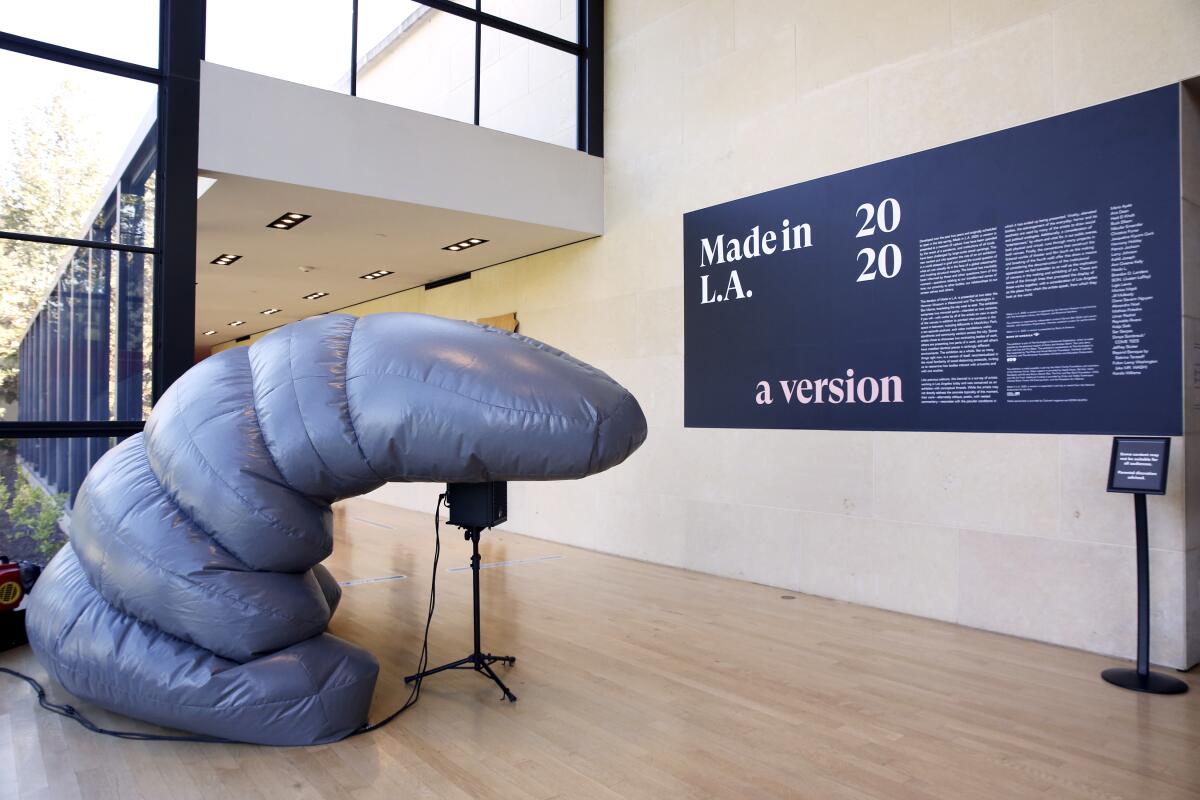
- Share via
Welcome to the Ooops I Forgot to Write the Newsletter edition of Essential Arts. I’m L.A. Times arts editor Craig Nakano filling in for columnist Carolina A. Miranda, who as you’ll see has been immersing herself in architectural solutions for people who are unhoused. This week has been bizzz-eee as California kicked its reopening into a higher gear, so there’s much to share. I’m sitting down to write at an hour when I’m usually in a seismic snore. My 2-year-old is asleep, the coffee is hot, the contact lenses are out and the glasses are on. Let’s do this.
Can’t keep a good show down
The Times doesn’t usually publish reviews for exhibitions that might not ever open. But there we were on Nov. 10, publishing critic Christopher Knight’s review of the “Made in L.A.” biennial while the state was hurtling toward a holiday spike of COVID-19 cases. With California museums shuttered for months and the outlook for winter looking grim, our critic flat-out asked the question: “Will ‘Made in L.A. 2020: a version’ ever open to the public?”
I remember editing the review and replying to my laptop screen: “No.”
Good thing editors are wrong. “Made in L.A.,” at long last, is opening. The Hammer Museum in Westwood and select galleries at the Huntington Library, Art Museum and Botanical Gardens in San Marino — co-host of “Made in L.A.” for the first time — begin welcoming visitors again Saturday.
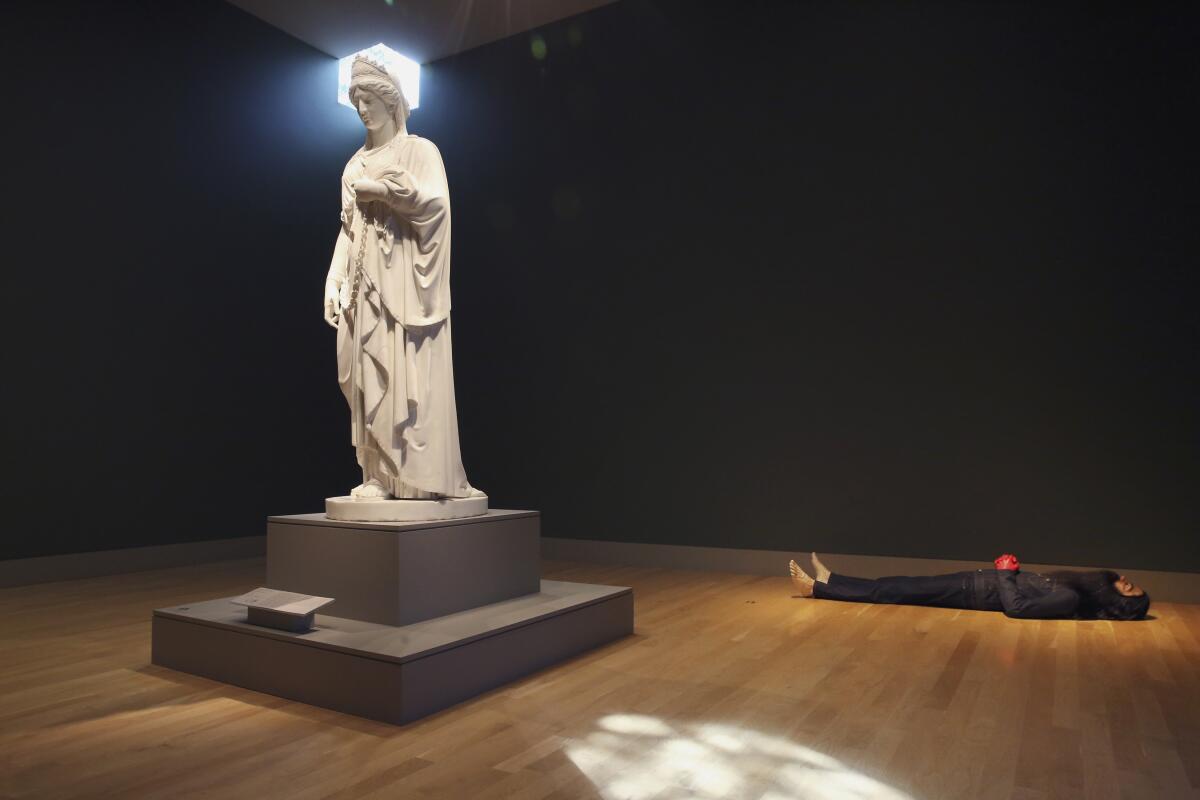
What to look for? Check out Knight’s review. At the Nov. 8 Huntington press preview (which seems like three years ago), I found myself drawn like a magnet to the Buck Ellison photography. And oh my god, I doubt there ever will be another instance of an animatronic male private part poking through a glory hole as part of an art installation in the staid confines of the Huntington. The Huntington! Make a reservation and go.
Before you head out, read staff writer Deborah Vankin‘s report from last July on how intrepid curators Lauren Mackler and Myriam Ben Salah, along with assistant curator of performance Ikechúkwú Onyewuenyi, scrambled to salvage the show amid a historic pandemic, and catch up on some biennial installations around town that you may have missed.
Make the most of L.A.
Get our guide to events and happenings in the SoCal arts scene. In your inbox every Monday and Friday morning.
You may occasionally receive promotional content from the Los Angeles Times.
A lot of museums are reopening, actually, making listings coordinator Matt Cooper a very busy man. I’m happy to report that so many SoCal institutions are back in business, we’ve restarted a weekly list of promising exhibitions to see. Make a reservation, mask up and, as my father-in-law used to say, get out of the house and blow the stink off ya.
If you’re desert bound, Knight has a show for you: “Agnes Pelton: Desert Transcendentalist” at the Palm Springs Art Museum. The painter’s dreamy, luminous work, Knight says, “secures her significant place among early American Modern artists.”
For an art experience of a different sort, the Los Angeles County Museum of Art has partnered with Snap to create give virtual installations across the region. As Vankin writes, the “Monumental Perspectives” project is meant to “add to the national conversation around representation and historical accuracy in monuments, murals and other public works of art.” Among the augmented reality pieces you can view: Ruben Ochoa’s scene of fruit carts floating over MacArthur Park.
Staff writer Jessica Gelt reports on the Ahmanson Theatre’s revised plans for a 2021-22 season, which now starts Nov. 30 with “A Christmas Carol” and includes the West End hit “Everybody’s Talking About Jamie.”
The Broad Stage in Santa Monica also sketched out some highlights, including commissions for a social justice opera by Wayne Shorter and Esperanza Spalding, work by choreographer Emily Johnson centered on First Nation creation myths and scored by Raven Chacon (“Sweet Land”), and a theatrical work of magical realism created by Angélique Kidjo with visuals by Kerry James Marshall.
Shipping containers as housing solution?
The week’s most-read arts story was Miranda’s subscriber exclusive walking readers through new SoCal design ideas for people who are homeless. She visits Chandler Street Tiny Home Village, a North Hollywood project of Lehrer Architects, and she tours Hilda L. Solis Care First Village, a $57-million development in downtown L.A. consisting of converted shipping containers and portable units for as many as 232 people. She also checks in with Lorcan O’Herlihy, whose firm is transforming shipping containers into 54 units of supportive housing in South L.A.
Writes Miranda: “My burning question has been: What exactly are these spaces like to live in?” Can structures that you might assume to be small, dark and dank actually feel livable? Can they feel like home? For answers and a peek at the designs, read the story.
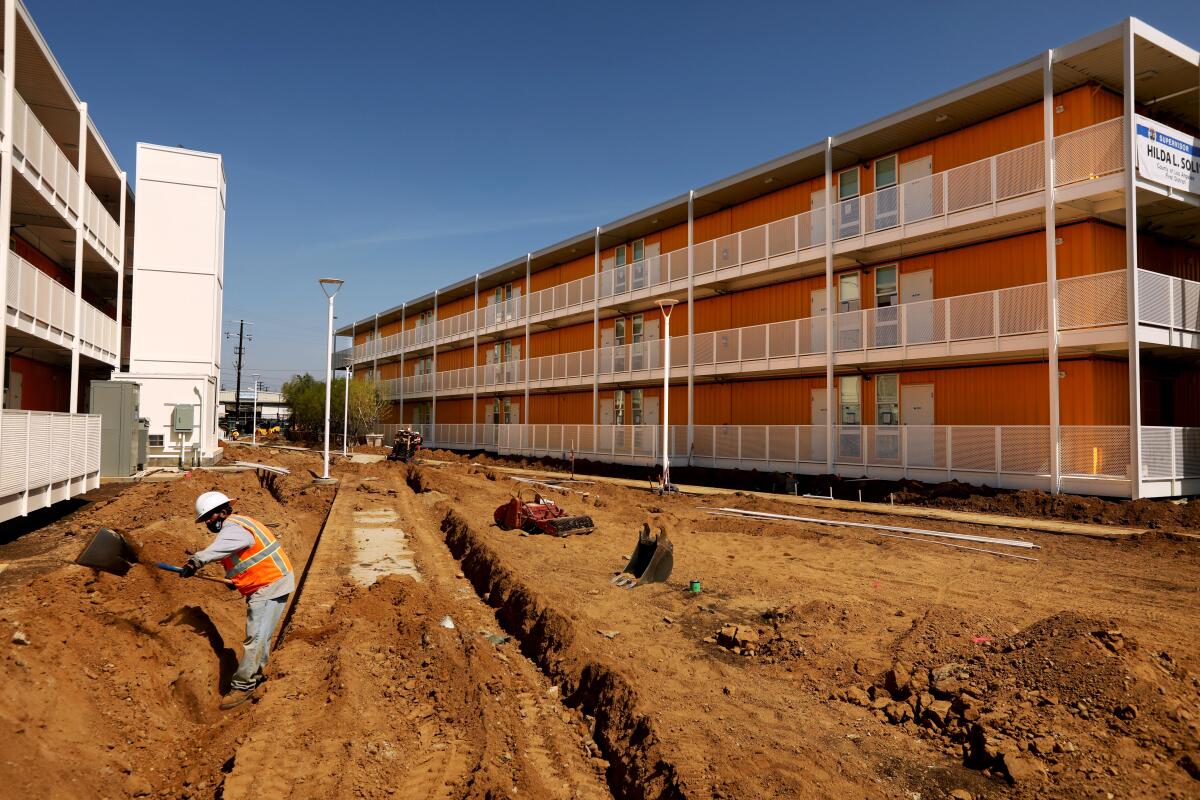
Long live Cinerama Dome
Another must-read of the week: ArcLight Cinemas and Pacific Theatres announced they were pulling the projector plug and would not be reopening. Film and architecture Twitter heated up with conflicting reports of what that meant for the historic Cinerama Dome. Could the 1963 design by midcentury icon Welton Becket and Associates — the world’s first all-concrete geodesic dome, L.A. Historic-Cultural Monument No. 659 — be torn down or gutted?
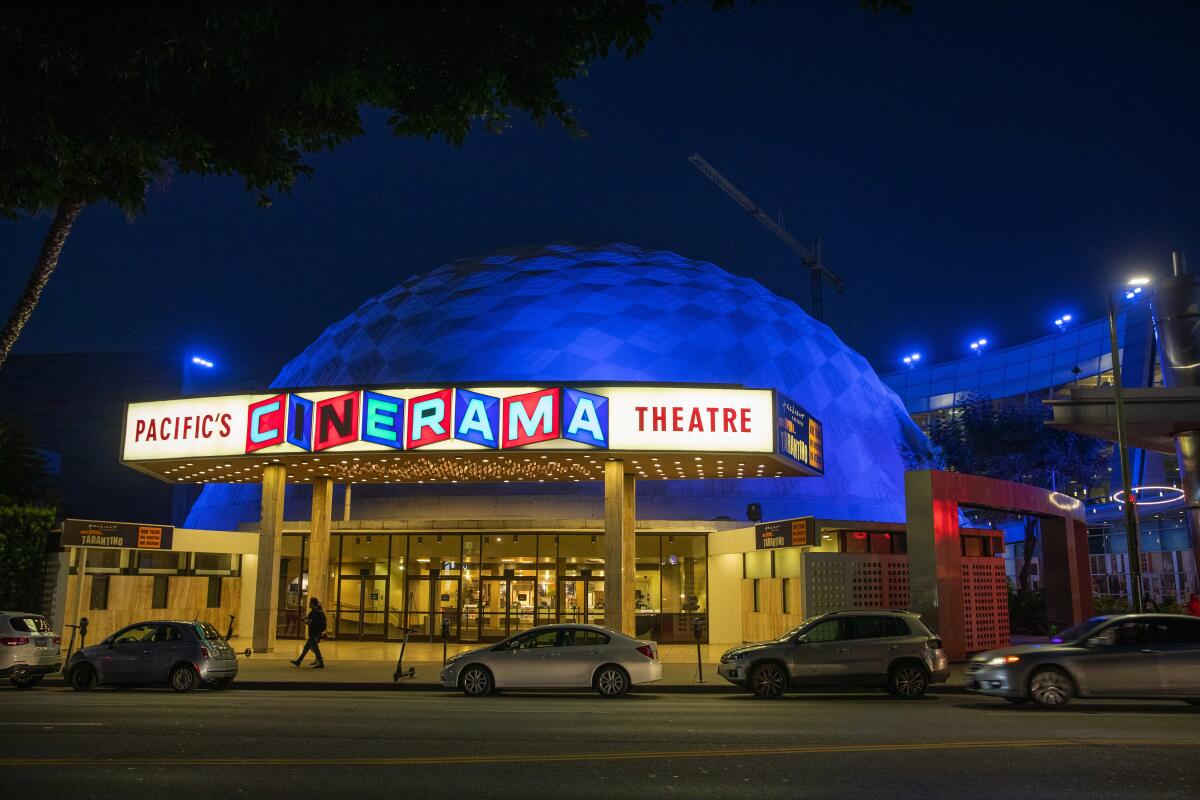
Technically, yes. Gelt and I agreed that we’d rather see our beloved Hollywood movie landmark torn down than turned into Cinerama Cheesecake Factory or Dave & Buster’s Dome. But Gelt silenced all the speculation on social with calls to L.A.’s Office of Historic Resources and the L.A. Conservancy, whose leaders explained why neither of those scenarios seemed likely.
Enjoying this newsletter? Consider subscribing to the Los Angeles Times
Your support helps us deliver the news that matters most. Become a subscriber.
Shakespeare and Sondheim
Critic Charles McNulty pulled up another seat to the virtual stage, this time to watch Oscar winner Lupita Nyong’o and “The Crown” star Josh O’Connor star in two riffs on “Romeo and Juliet” — she in the Public Theater’s bilingual podcast “Romeo y Julieta,” he in a National Theatre film airing on PBS’ “Great Performances.” Together, McNulty writes, the twin takes on Shakespeare prove how “in a world riven by inequities and grudges, the story of these young lovers helps us see the gentler, kinder and more sensual lives we could be living.”
McNulty also catches “Tell the Story: Celebrating Stephen Sondheim and John Weidman’s ‘Assassins,’” a recorded benefit for Classic Stage Company that probes the weird appeal of a musical centered on people who killed or have tried to kill a U.S. president. (“‘Audacious’ seems far too tame for a musical that searches for the pep in pathological and even makes treason tuneful,” McNulty writes.) Ultimately the emotional pull of so many cast, crew and creatives at this moment in the pandemic — the sense of what’s at stake in the survival of theater — proves as powerful as any song.
And you thought your commute was bad
Gustavo news alert: Dudamel, the beloved artistic and music director of the Los Angeles Philharmonic, accepted an appointment Friday to be music director of Paris Opera. Our critic Mark Swed has the details of how Dudamel will keep his position in L.A. and shuttle between California and France for at least five years. The conductor returns to L.A. for the May 15 reopening of the Hollywood Bowl, a special free concert for hospital workers, grocery store employees, delivery drivers and other essential workers.
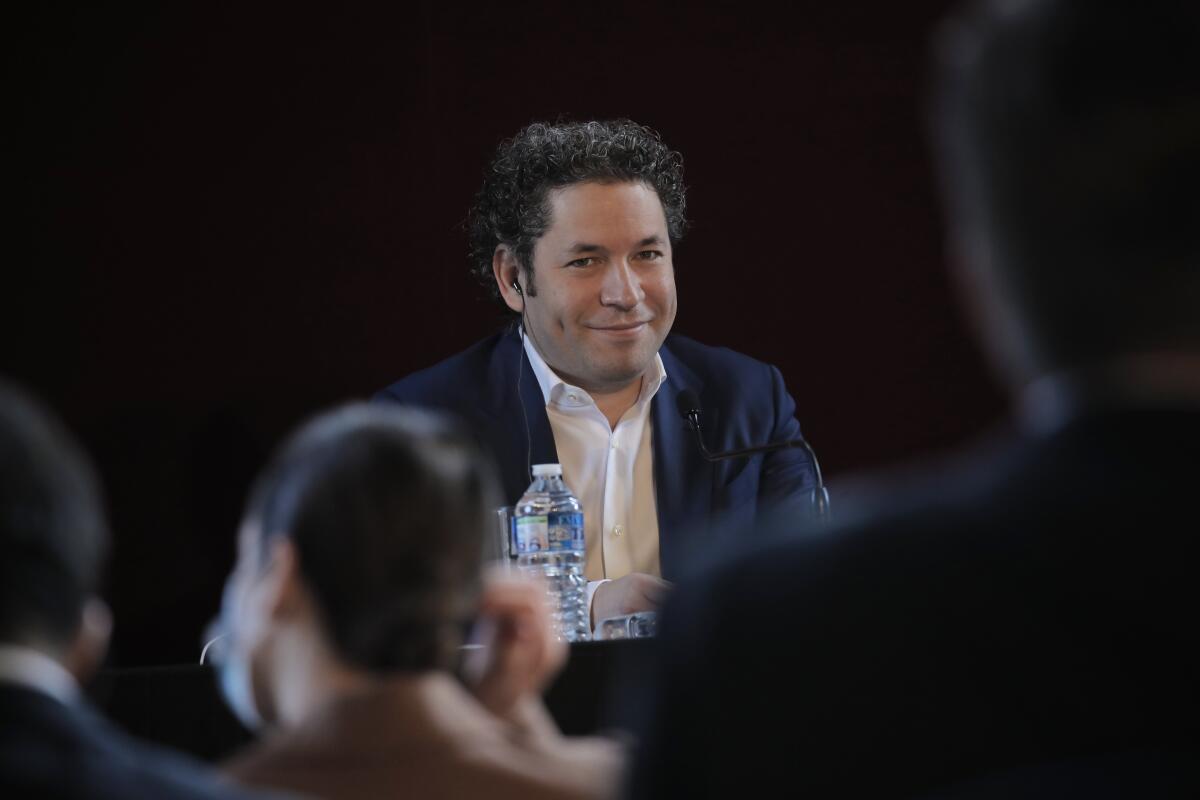
Briefly ...
While the rest of us try to deny their existence, staff writer Matt Pearce bravely swims NFT waters for a piece headlined “Who Can Sell a Wonder Woman NFT? The Guy Who Drew Her or DC Comics?”
If you hadn’t yet heard, Frieze Los Angeles has been canceled for 2021. Vankin explains how the event will return in 2022 — but not to the Paramount backlot.
Contributor Michael Rechtshaffen reviews “Bill Traylor: Chasing Ghosts,” a documentary about the man who was born into slavery, started making art at age 85, died in 1949 and didn’t gain much attention until the 1970s. Rechtshaffen’s assessment of the film, in two words: “hauntingly intriguing.”
And if you still need some ideas of things to do, Cooper has 23 more picks for weekend culture.
Warning: self-serving promotion ahead
Some applause for Team Arts here at The Times: The National Arts & Entertainment Journalism Awards announced its winners, and the list was packed with names familiar to Essential Arts readers.
Staff writer Makeda Easter, in addition to placing third for print journalist of the year, won two categories: multimedia package (with Claire Hannah Collins, J.R. Lizarraga and Vanessa Martínez) for her “Rise of the Dancefluencer,” and visual arts/architecture feature for “Slavery Documents From Southern Saltmakers Bring Light to Dark History.”
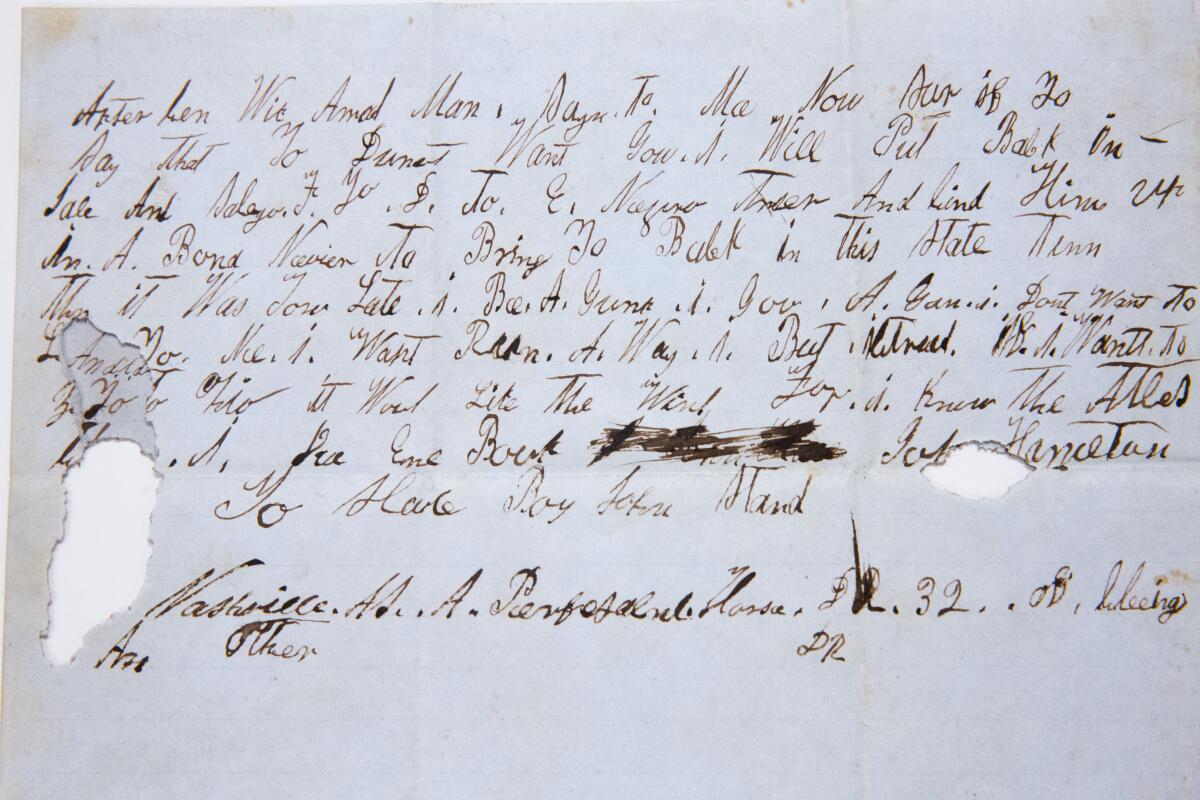
McNulty placed first in column writing for a selection of work that included his memorable “President Trump vs. Oedipus Rex: Leaders Reveal Themselves in Times of Plague.” McNulty also placed first in the arts commentary analysis/trend category for his pre-pandemic piece “As Center Theatre Group Sputters, L.A. Struggles to Realize Its Artistic Potential.”
Knight and Miranda delivered a 1-2 punch in in the art/design criticism category, placing first and second for selections of work that included a proposal to build a national COVID-19 memorial on the site of Trump Tower and a discussion of how the lack of Latino representation in mass media and the then-president’s xenophobic rhetoric is a recipe for the kind of race-based violence plaguing the country.
Contributor Lisa Fung and Gelt dominated the theater arts feature category, finishing first and second for pieces centered on fictional work about an innocent man sentenced to death and a real-life project to hold theaters to account for systemic racial bias. Check out “‘The Wrong Man’ Musical’s Epic Journey to the Stage, With Help From Team ‘Hamilton’” and “The Spreadsheet That Shook the Theater World: Marie Cisco’s ‘Not Speaking Out’ List.
Deborah Vankin, a frequent presence in these awards, was honored again, this time with a third place finish in the visual arts/architecture feature category: “Holocaust Survivor Portraits at USC Museum Call on ‘Profound’ Beauty to Fight Hate.”
That’s a wrap
Thanks for hanging in till the end! It’s now Saturday. The sun is up, the 2-year-old is awake, there’s more coffee to brew. Let’s get out and do something.
The biggest entertainment stories
Get our big stories about Hollywood, film, television, music, arts, culture and more right in your inbox as soon as they publish.
You may occasionally receive promotional content from the Los Angeles Times.




